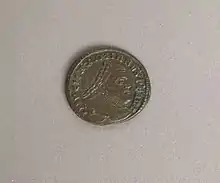Nummus
Nummus (Greek: νοῦμμος, noummos), plural nummi (νοῦμμοι) is a Latin term meaning 'coin', but used technically by modern writers for a range of low-value copper coins issued by the Roman and Byzantine empires during Late Antiquity.[1] It comes from the Greek nomos via its Western Doric form noummos,[2][3] which was used to describe a coin in some parts of southern Italy. The word was also used during the later years of the Roman Republic and the early Empire, either as a general word for a coin, or to describe the sestertius, which was the standard unit for keeping accounts.

History

.jpg.webp)
In circa 294 AD, during the Tetrarchy, a new large bronze coin of circa 10 grams weight and 30 mm diameter appeared. Its official name was apparently nummus, although it has until recently been known among numismatists as the follis.[4] The term nummus is now usually applied solely to the 5th–7th century Byzantine issues. These were small, badly struck coins, weighing less than 1 gram, forming the lowest denomination of Byzantine coinage. They were valued officially at 1⁄7,200 of the gold solidus but more usually rated to 1⁄6,000 or 1⁄12,000.[4] The nummus usually featured the profile of the reigning Byzantine emperor on the obverse and the Byzantine imperial monogram on the reverse, although some coins of Emperor Justinian I (r. 527–565) display its numerical value by the Greek numeral "A" instead.[4]
Higher denominations
In 498, Emperor Anastasius I (r. 491–518) reformed the coinage (carried out by the comes sacrarum largitionum John the Paphlagonian[5]) by introducing multiples of the nummus, with denominations of 40 nummi, also known as a follis, 20 nummi (semifollis), 10 nummi (Greek: δεκανούμμιον, decanummium). These were also marked with Greek numerals representing their value: "M" for the follis, "K" for the semifollis and "I" for the decanummium. On the other hand, it appears that issue of the simple nummus was discontinued.[6] In 513, the weights of these coins were doubled, the pentanummium (Greek: πεντανούμμιον, 5-nummi coin marked with "E") introduced, and the minting of single nummi resumed.[7]
Decreasing value
In 538–539, Emperor Justinian I introduced further changes to the 40-nummi follis, raising its weight to 25 grams. It was reduced again to 22.5 grams in 541/542, and further reductions followed until the century's end. At this time, a new 30-nummi coin (marked with "Λ" or "XXX") was introduced, but the single follis had ceased to be struck at Constantinople. It survived in the Exarchate of Carthage well into the 7th century however.[4][8] During the 7th century, the successive military and financial crises led to further reduction in the weight and a marked deterioration of the quality of bronze coinage; by the time of Emperor Constans II (r. 641–668), a follis weighed only 3 grams. Consequently, the denominations lower than the semifollis were practically unmintable and abandoned.[9] Thereafter, the term nummus remained in use as a notional unit for 1⁄6,000 of the solidus, and in colloquial usage for "small change".[4]
Use of term
Variations of the term nummus appear in medical language, plant taxonomy, and fossil taxonomy:
- Arctostaphylos nummularia
- Atriplex nummularia
- Biscogniauxia nummularia
- Bulbophyllum nummularioides
- Capparis spinosa subsp. nummularia
- Correa reflexa var. nummulariifolia
- Dorstenia nummularia
- Eriogonum nummulare
- Helianthemum nummularium
- Lysimachia nummularia
- Nummular dermatitis
- Nummulite
- Pilea nummulariifolia
- Ziziphus nummularia
References
Citations
- Moretti, Federico (1828). Diccionario militar español-francés. Imprenta Real de Orden Superior. p. 116.
- Klose, Dietrich (Munich). "Nummus." Brill's New Pauly. Antiquity volumes edited by: Hubert Cancik and Helmuth Schneider. Brill Online, 2015. Retrieved 02 June 2015
- νοῦμμος, νόμος. Liddell, Henry George; Scott, Robert; A Greek–English Lexicon at the Perseus Project.
- Kazhdan, Alexander Petrovich, ed. (1991). The Oxford Dictionary of Byzantium. New York, New York and Oxford, United Kingdom: Oxford University Press. p. 1504. ISBN 978-0-19-504652-6.
- Hendy, Michael F. (1989). The Economy, Fiscal Administration and Coinage of Byzantium. London, United Kingdom: Variorum Reprints. p. 89. ISBN 0-86078-253-0.
- Grierson 1999, pp. 17–18.
- Grierson 1999, p. 18.
- Grierson 1999, pp. 18–19.
- Grierson 1999, p. 19.
Sources
- Grierson, Philip (1999). Byzantine Coinage (PDF). Washington, District of Columbia: Dumbarton Oaks. ISBN 978-0-88402-274-9. Archived from the original (PDF) on 2010-06-13. Retrieved 2010-03-11.
Further reading
- Bates, George Eugene (1971). Byzantine Coins. Cambridge, Massachusetts: Harvard University Press. ISBN 9780674089655.
- Grierson, Philip (1982). Byzantine Coins. London, United Kingdom: Methuen. ISBN 978-0-416-71360-2.
- Hendy, Michael F. (1985). Studies in the Byzantine Monetary Economy c. 300–1450. Cambridge, United Kingdom: Cambridge University Press. ISBN 0-521-24715-2.
- Sear, David R.; Bendall, Simon; O'Hara, Michael Dennis (1987). Byzantine Coins and their Values. London, United Kingdom: Seaby. ISBN 9780900652714.
- Whiting, Philip D. (1973). Byzantine Coins. New York, New York: G.P. Putman. ISBN 9780399110283.